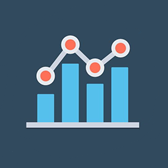
For large and growing B2B businesses, the value of data is difficult to overstate. Studies show that in-depth data analysis can improve sales growth and customer relationships, and the effects are most pronounced in businesses that have a strong analytics culture.
Understanding the intricacies of capturing and analyzing data is the first step to establishing such a culture. This article will provide information on the types of data analytics you’ll want to pay attention to, how you can turn data into actionable insights, methodologies to be aware of, and the overarching benefits of it all.
An Introduction to Data
First, a clear definition of big data is in order. In the simplest terms, this phrase is used to describe large, complex sets of data. More specifically, though, big data has three defining characteristics, often referred to as the “V’s” of big data:
- Volume: The amount of data is important, but this alone isn’t what defines big data. To qualify, you’ll need to have large quantities of low-density, unstructured data to process, the exact amount of which will vary based upon your company’s needs.
- Variety: Big data doesn’t exist solely in one form, rather, it’s available in many structured, unstructured, and semi-structured forms that may require additional processing to gain any meaning from. This includes conventional datasets, as well as images, videos, audio recordings, and even IoT-connected devices.
- Velocity: Another aspect that makes big data so useful for businesses is the fact that it comes at you fast. With the right technologies, you generate, process, and analyze data in “real-time” at speeds within a fraction of a second.
- Veracity: Finally, big data runs the gamut of authenticity and credibility (on account of its immense volume), as opposed to smaller data sets, which are easier to manage and often trend toward a higher degree of veracity.
For B2B operations, big data has a wide range of use cases, but it’s often meaningless in its raw, unprocessed state. To have value, you’ll need a way to interpret the data you’ve got.
From Data to Strategy
How do you get from messy data to actionable insights? Data analysis (which we’ll be covering in a moment) plays a big part, but you’ve also got to think big picture with methodologies like business intelligence. This broad-reaching term is key to bridging the gap between data and strategy, and takes place over five stages:
- Gathering data: This is where you collect information from your data sources, such as databases, CRMs, and other forms of software.
- Analyzing data: Next, your team must turn raw data into knowledge and insights that you can further process. This stage often requires powerful software.
- Contextualizing data: Bring the human element into your analytics by adding customer-related context to whatever your analysis has revealed, and using non-jargon language to assess all the possible ways to put your data into action.
- Assessing risk: Not every actionable strategy carries the same benefits and drawbacks. Again, a human touch is necessary to ascribe risks and weigh those against reward for each possible course of action.
- Selecting strategies: By comparing your possible courses of action with your intended end goals, you and your team can choose the strategies that will best meet your needs.
Altogether, these steps will allow you to focus analysis into something practical, but they still hinge on performing those analytics as a prerequisite. Next, let’s take a look at the most common ways in which you can use analysis to unmask trends from raw data.
Various Methods of Analysis
Data analysis isn’t a one-size-fits-all kind of process. There are four methods you should familiarize yourself with if you want to maximize the potential for your business:
- Descriptive analytics: This is the most popular type of analysis, answering the what of the matter and taking a close look at performance metrics. You can think of descriptive analytics as just the facts and nothing more. This method is great for establishing a starting point for other forms of analysis.
- Diagnostic analytics: Diagnostics look at why things played out how they did, so they require you to dig deeper into historical data to arrive at answers. Diagnostics serve as an excellent secondary analysis, adding context and helping to isolate patterns, uncover relationships, and identify outliers within your pool of data.
- Predictive analytics: If you want to know about the what-ifs concealed within your data, predictive analytics are the way to go. Building upon the previous two types of analysis, predictive analytics can give you an idea of what is likely to occur should certain conditions be met, albeit, with imperfect accuracy.
- Prescriptive analytics: Finally, prescriptive analytics can provide you some insight into how you can make things happen. This can give you an advantage when trying to plan your next steps but poses a high barrier to entry for most businesses because of the need for highly-skill personnel such as data scientists and technology like AI and machine learning necessary to get it done.
You’ll need to carefully consider how these forms of analytics might fit into your plan and how they’ll mesh with your business intelligence schemes to arrive at the best choices for your organization.
What’s the Point?
Why bother with analytics at all? The positive impacts that data mining, analysis, and their subsequent incorporation into a business intelligence framework are clear.
B2B businesses gain the ability to better focus data into insights you can use to gain an advantage over your competition, while minimizing the chances that you’ll make a strategic misstep. To bring it all together, make sure you focus your analytics on clearly defined business objectives, make your insights easy to comprehend, and collaborate with your entire team to maximize information sharing and minimize data blind spots.
